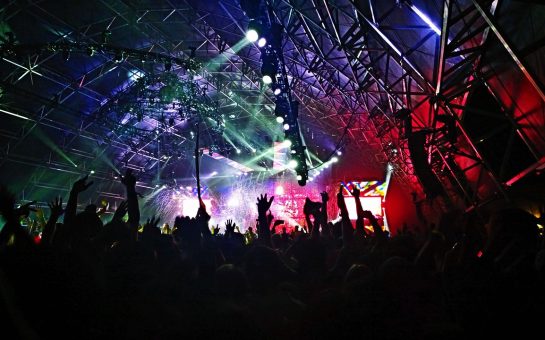It is arguably Manchester’s most iconic building.
Adolf Hitler is thought to have spared it from bombing as he eyed it for the Nazi headquarters in Britain should he have won the war.
And it has been the setting for countless meetings that have shaped British history since the turn of the twentieth century, notably where Mr Rolls met Mr Royce.
It’s even home to The French – one of the city’s finest restaurants, which was seen narrowly missing out on a Michelin Star in TV show Restaurant Wars last night.
Yet there’s one woman who knows Manchester’s Midland Hotel better than most – and whose life is inextricably linked to the grade II* listed building.
Barbara Frost has spent much of the last 27 years bringing the rich past of the hotel to life for countless numbers of visitors.
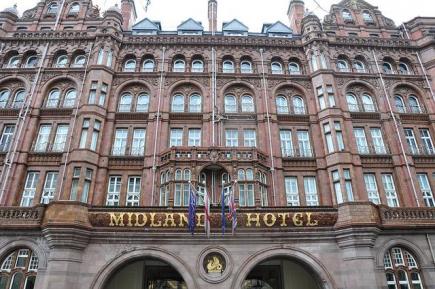
ICONIC: The Midland Hotel (image courtesy of Ben Sutherland, with thanks)
MM were lucky enough to spend an afternoon with the Blue Badge guide and author of ‘Memories of the Midland’.
Her first visit was in 1957 and she still remembers with a smile her mother saying to her: “If you are going to the Midland Hotel for tea, don’t forget your gloves.”
At that time, Barbara knew little of the history of the Midland, but now she is surely the leading authority of every aspect of its 111 year history.
Her close association began in 1987 when, almost on a whim, she had an inspired idea that was to change the course of her life.
While working at Manchester City Council doing administrative work, in her spare time she pursued her first love: tourism.
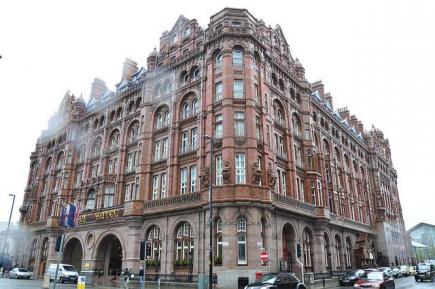
STEEPED IN HISTORY: Charles Stewart Rolls met Frederick Henry Royce at the hotel, leading to the formation of Rolls Royce (image courtesy of Ben Sutherland, with thanks)
She became a fully-qualified Blue Badge Guide and in 1982 while still holding down a full-time job, she became a self-employed guide for the North West Tourist board.
It was when she was leading a guided walk around Castlefield that she made the leap of faith.
“I was leading a walking tour around Manchester in our typical weather – cold and wet – and ended up outside the Midland,” Barbara said.
“I came in for a cup of tea and got chatting to a waiter about the hotel and he showed me round and I thought to myself ‘I wonder if they need a tourist guide for the hotel’?”
Barbara laughs that it was an odd idea and at first the hotel was not persuaded.
But Barbara was not about to give up easily on what she thought was a good idea and she managed to eventually convince the hotel management to give it a try.
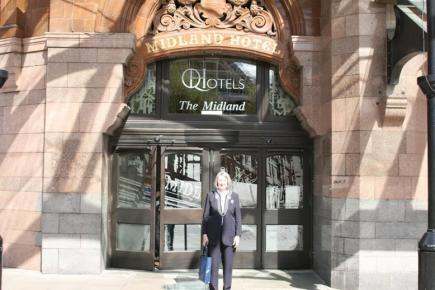
WELCOME TO THE MIDLAND: Barbara Frost has spent much of the last 27 years bringing the rich past of the hotel to life
This was in 1987, just after the hotel had re-opened after its two year refurbishment.
The success of the Midland tours gave Barbara the confidence in her ability to go full-time with her passion.
“I was bored with my full-time office job, the walks had been reasonably successful, I was 50 years old by now and just thought to myself that I would give it a go full-time and so began working as a self-employed tourist guide,” she said.
Since that time, Barbara, who is probably the first ever official hotel tour guide in the world, has spent hours and hours researching the history of the hotel, its people and the guests that have stayed there over the last century.
Beginning its life as a ‘railway hotel’, the Midland was built by Midland Railway as the Northern end of the London line.
Opening in 1903, the Midland has a fascinating architectural and social history and its walls contain a wealth of tales concerning Manchester and its people.
We began next to the Octagon Court, one of the busiest parts of the hotel used for morning coffees, lunches and afternoon teas.
Along walls surrounding the court are framed hand-written verses that make up WH Auden’s famous poem the Night Mail – reminding visitors of the railway history of the hotel.
In the latter part of the nineteenth century the Midland Railway Company ran their base in the east Midlands across the whole of the country and built a series of hotels for its travelling guests.
By 1890 it already had hotels in Bradford, Derby, Morecambe, Liverpool and London but not in Manchester.
Prompted by complaints from its customers that the hotels in Manchester were not luxurious enough, the company decided to build a hotel in Manchester and settled on a site very close to Manchester’s Central Station which was completed in 1880.
The Midland was always intended to be an exceptionally grand hotel and was designed and constructed to a very high specification, containing many of the latest innovations.
It took five years to build and cost nearly £1.5million – an enormous sum in those days.
It opened in 1903 and was immediately recognised as one of the finest and most expensive hotels in the country.
Over the years it has changed hands several times. Nationalisation of the railways saw the hotel move into the hands of a new British Transport Commission in the 1960s and then in 1983 it was sold to the Greater Manchester Councils and Commercial Unions Assurance Partnership. It is now owned by Qhotels Group.
Next to the Octagon Court is the Wyvern bar, so named because the Wyvern was a symbol of the Midland Railways.
The feature that stands out in this bar is the collection of photographs of acrobats and horses by Eadweard Muybridge who spent many years looking at the gait of horses so artists could paint them more accurately.
Barbara makes a point of taking every new owner on a tour of the hotel and likes to impress on them the importance of the history of the hotel and of its unique character.
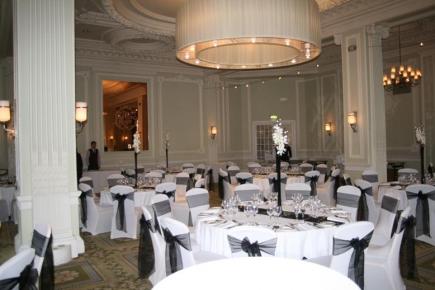
HISTORY AND CHARACTER: The Trafford Room
She is pleased that the current owners QHotels have done much to retain and enhance this history and character.
Even from a casual walk around, it is noticeable how many of the original features have been retained – not least some of the original plaster mouldings in rooms such as the Trafford Room.
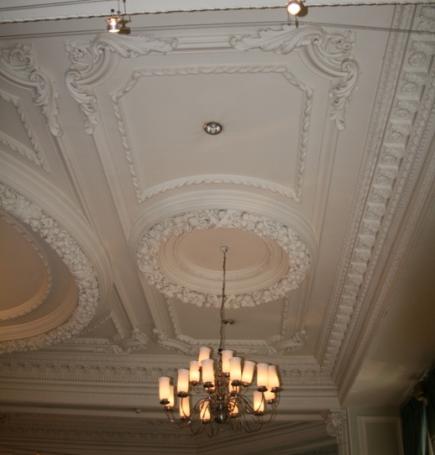
ORIGINAL FEATURE: Current owners QHotels have worked hard to preserve original plaster mouldings in rooms such as the Trafford Room
One of Barbara’s favourite parts of the hotel is the newly-opened Mr Cooper’s House and Garden – a restaurant and bar used by hotel guests and members of the public who can access it from Mount Street.
But where did the name Mr Cooper’s come from?
When the site was first acquired there were a number of existing buildings on the site – concert halls, a casino and a school but also a house and garden belonging to a Mr Cooper.
Mr Cooper kept a famous and well-known garden, so much so that the nearby Cooper Street was named after him.
When the hotel decided to refurbish this part of the hotel, they decided to honour his memory and have designed an imaginative restaurant and bar, divided up into areas reminiscent of the original house and garden complete with a study, a library and even a garden area with its own tree.
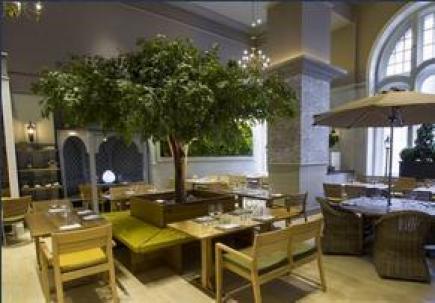
HONOURING HIS MEMORY: Mr Cooper lives on as his garden is recreated in the bar (image courtesy of Mr Cooper’s House and Garden, with thanks)
“This is the original marble staircase from the sixth floor to the ground floor,” she explained as we neared the imposing stairs. From here the facts and observations came thick and fast.
“The hotel has seventeen different types of marble.”
“This is the Rolls suite and Royce suite – they met in the hotel in 1904 and it was from this meeting that Rolls Royce cars began.”
“The roof of the hotel was at one time used for afternoon teas as Mr Trubshaw, the architect, was so fascinated by the view of Manchester and the Pennines that he wanted to share this with guests. In 1910 the wedding reception of Israel Seiff and Rebecca Marks (of Marks & Spencer fame) was held on the roof.”
As if running hotel tours was not enough – in her time she reckons she must have shown thousands of people around – Barbara expanded her tourist operation into other areas.
From a small desk in the hotel foyer – this desk was part of the original 1903 hotel furniture – Barbara was on hand at weekends to offer tourist information to guests and began taking groups of visitors for tours around Manchester shortly after beginning as the hotel tour guide.
Not content with this already demanding schedule, she has also branched out into coach tours along with her fellow guide Joan Clough, including tours to Derbyshire, a Lancashire Witches tour to Pendle, a Last of the Summer Wine tour and also tours around Liverpool.
Continuing our tour, we move on to the one-time Gentleman’s Reading Room, now a fine wood panelled function room and told me about the fantastic effort that was made to preserve the wonderful plaster moulding in the corridor outside.
During the refurbishment between 1985 and 1987, these mouldings fell from the ceiling and were smashed into hundreds of tiny pieces.
Rather than lose them for good, they were painstakingly collected and pieced together into a form from which a mould could be made and the plaster moulds re-created.
This attention to detail and determination to retain the hotel’s history is of great credit to the hotel owners and people should be aware of the effort that goes into maintaining the character of the hotel.
“If I didn’t tell people, nobody would know,” she said.
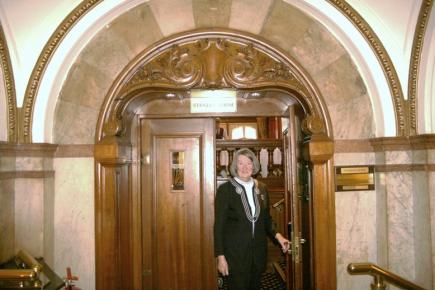
MEN ONLY? The former Gentlemen’s Reading Room is now a function room – with no gender stipulations
At the back of the hotel, there is a large set of doors that look directly across to the Manchester Conference Centre.
This is the original site of the Central Station for which this hotel was built and there is still evidence on the walls of the fixings for the covered walkway that stretched from the back of the hotel to the station to allow the rich and powerful to walk across without getting wet.
Along the corridor from this entrance into the hotel are a series of pictures taken from the London to Manchester train detailing the journey there and back – yet another detail linking the modern hotel to its rich past.
The hotel not only tells its own history but also the history of Manchester – nothing demonstrates this more effectively than the German Restaurant.
During the second half of the nineteenth century Manchester was the major textile centre in Europe – hence its nickname of Cottonopolis.
It was because of this that textile companies from across Europe and especially Germany felt compelled to open a Manchester branch.
One very famous immigrant was Friedrich Engels who was sent to Manchester by his parents to run the English end of their cotton business – it was this experience that no doubt that led to his eventual collaboration with Karl Marx.
When the hotel was built, they created a German Restaurant in the basement of the hotel to cater for this large German community.
The door to the restaurant comes directly off Mount Street and to entice clientele in and also one supposes to make them feel at home, a magnificent tiled staircase was installed with bespoke tiles in the German style of the day.
Luckily this staircase still remains and is now the entrance to the leisure centre. It is worth visiting the hotel for this feature alone.
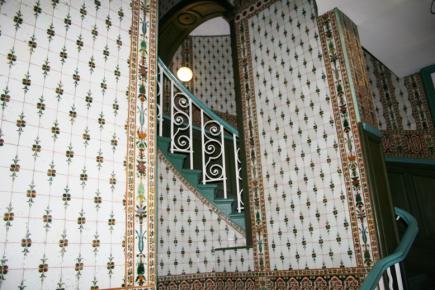
THE DEUTSCH CONNECTION: The tiled staircase installed with bespoke tiles in the German style of the day
Once, when leading a tour she was told by one visitor that they would never remember everything they had learnt and that she should write it all down.
Her initial reaction was that she could not possible write a book.
“I’d never written anything in my life but the woman said to me, ‘just go home and start writing’,” she said
“Which is what I did. There was a lot of work involved, researching the hotel, looking through endless microfiche of past newspapers in the library and so on.
“Most of the information, though, came from talking to the staff here. There were very few official records but some of the staff had long family connections with the hotel.
“The head concierge, Mike Leibrick was an especially good source. His mother and grandmother had both worked here and he has an amazing memory – in some cases not only can he remember the names of guests who stayed here years ago but can even remember their room number!”
Twelve months later in 1992, Barbara published her first book, Memories of the Midland in which all these details and far more are contained. This book was updated in 2003 to celebrate the centenary of the hotel and the last edition was published in 2007 to incorporate changes made by the current owners, QHotels.
Speaking of her life and her experiences in the tourist industry, Barbara says she feels very lucky in her life to have been able to do so many interesting things.
The history of the Midland Hotel and of Barbara Frost are now inextricably linked. It is because of Barbara’s dedication and love of the hotel that so much of its history is available to us.
More than that, it is also because of Barbara’s continuing involvement with the hotel that the history of the Midland is being retained and enhanced – it is in no small part due to her presence that successive owners have done so much to preserve the heritage of one of Manchester’s most important buildings.
Main image courtesy of Ben Sutherland, with thanks.



